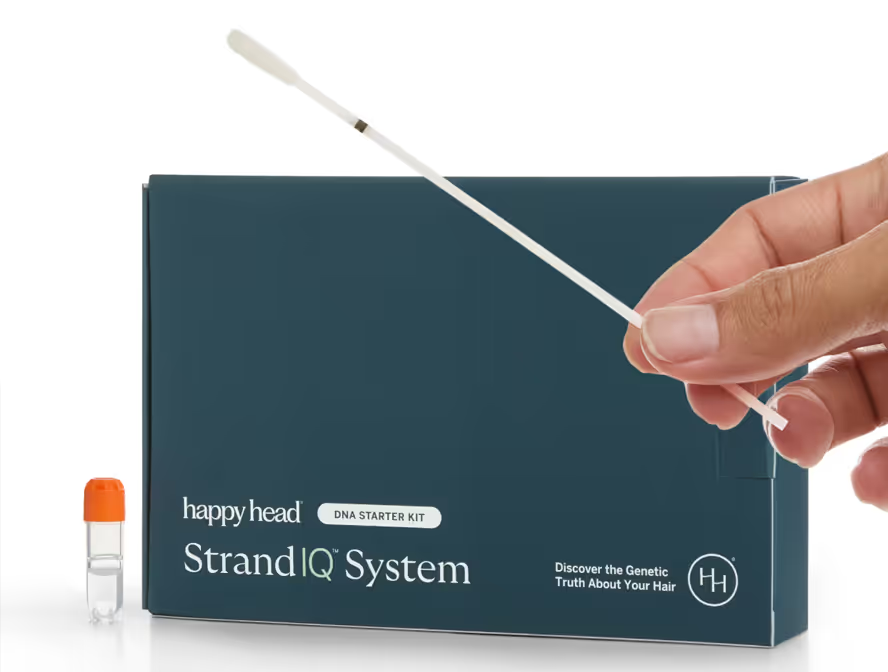Your scalp is more than just the foundation for your hair—it's a protective barrier that defends against environmental toxins, allergens, and microbial invaders. At the heart of this defense system is the Stratum Corneum (SC), the outermost layer of your skin. A healthy scalp barrier locks in moisture and keeps out harmful irritants.
But what if you inherited a naturally weak defense?
Genetic variations in the filaggrin (FLG) gene can compromise the integrity of your scalp barrier, increasing your risk of irritation, dryness, dandruff, allergies, and inflammation. Up to 10% of Europeans carry these mutations—often without knowing it.
Understanding your genetic predisposition can help you proactively care for your scalp and avoid unnecessary damage. Here's what you need to know.
The Science Behind Scalp Barrier Dysfunction
FLG is a protein that plays a vital role in skin hydration and barrier function. It helps form the structure of the outermost skin layer and aids in moisture retention. However, people with mutations or deletions in the FLG gene produce less filaggrin, leading to:
- Increased skin permeability
- Greater sensitivity to hair products and allergens
- Elevated risk for eczema, asthma, dandruff, and even peanut allergies
When your scalp barrier is compromised, irritants can penetrate the skin more easily—causing redness, dryness, itching, and inflammation. Over time, this chronic stress on the scalp can even impact hair follicle health, leading to breakage or thinning.
Personalized Scalp Barrier Care Based on Genetic Risk
Whether your Happy Head StrandIQ analysis has identified you as being at a genetically low, moderate, or high risk, adopting targeted scalp care strategies can help restore balance and protect your barrier.
Low Genetic Risk: Maintain a Healthy Barrier
If your StrandIQ analysis has identified you as being at low risk for scalp barrier function then simple changes to your scalp care routine may be all you need:
- Use moisturizing products
Choose shampoos and conditioners with formulas containing hydrating ingredients like glycerin, ceramides, or hyaluronic acid to support scalp hydration. - Exfoliate weekly
A gentle scalp scrub or soft-bristle brush can help remove dead skin cells, oil, and product buildup without damaging your natural oils. - Stay hydrated
Drinking adequate water—about four to six cups a day—supports skin cell turnover and moisture retention from the inside out.
Medium Genetic Risk: Boost Moisture and Reduce Irritants
If you’re at a moderate genetic risk for scalp barrier dysfunction—or if you have noticed that your scalp is irritated, dry, or flaking—then it may be time for more intensive interventions:
- Switch-up your haircare routine
Opting for high-quality, barrier-safe hair products such as sulfate-free shampoos and conditioners will help prevent the natural oils from being stripped from your scalp and improve hydration. - Evaluate your hair products
If you're experiencing sensitivity or dandruff, eliminate potential irritants like fragrances, alcohols, and harsh preservatives. - Check your diet
In some cases, scalp irritation may be linked to food sensitivities—beware of consuming foods containing hidden allergens such as egg, milk, and soy. Consult your healthcare provider if symptoms persist.
High Genetic Risk: Restore and Rebuild Your Barrier
- Choose moisturizing products
Sulfate-free, deeply moisturizing products with natural oils, ceramides, and panthenol can reinforce your weakened scalp barrier. - Implement a pre-shower routine
Use coconut oil, jojoba oil, or argan oil before shampooing to create a protective seal and prevent over-cleansing. - Check for irritant exposure
Reevaluate hair products, laundry detergents, or even pillow fabrics that may trigger irritation. - See a dermatologist
Persistent scalp discomfort, itching, or flaking may require professional evaluation with a Happy Head dermatologist, especially if linked to a genetic barrier dysfunction.
Strengthen Your First Line of Defense
Your scalp’s barrier function is its first line of defense—and if your genetic profile puts it at risk, you don’t have to wait for symptoms to act. By choosing scalp-friendly products, staying hydrated, and minimizing irritant exposure, you can create a strong, supportive environment for your skin and hair.
It all starts at the root—literally.
Resources
StrandIQ SNP Marker Count: 2
StrandIQ Genes for Trait:
CCDST, FLG
References:
Irvine, A.D., McLean, W.H.I., Leung, D.Y.M. (2011). Filaggrin loss-of-function variants are associated with atopic dermatitis and a defective skin barrier. Journal of Allergy and Clinical Immunology, 127(3), 692–699.e1. PMID: 21334333.
Palmer, C.N.A., et al. (2006). Common loss-of-function variants of the epidermal barrier protein filaggrin are a major predisposing factor for atopic dermatitis. Nature Genetics, 38(4), 441–446. PMID: 16682950.
Sandilands, A., et al. (2007). Comprehensive analysis of the gene encoding filaggrin uncovers prevalent and rare mutations in ichthyosis vulgaris and atopic eczema. Nature Genetics, 39(5), 650–654. PMID: 17460637.
Smieszek, S.P., et al. (2020). Correlation of age-of-onset of atopic dermatitis with filaggrin loss-of-function variant status. Scientific Reports, 10, 2721. PMID: 32094441.
Stawczyk-Macieja, M., et al. (2015). Genetic background of skin barrier dysfunction in the pathogenesis of psoriasis vulgaris. Postępy Dermatologii i Alergologii, 32(2), 123–126. PMID: 26015782.
This content, including StrandIQ™ DNA analysis reports and any Happy Head products and/or services referenced therein, is for informational and cosmetic purposes only. It is not intended to diagnose, treat, cure, or prevent any disease. This content does not constitute medical advice and should not be used to make healthcare decisions. References to prescription treatments are educational in nature. Always consult a licensed healthcare professional for any medical concerns or treatment decisions.








.avif)

